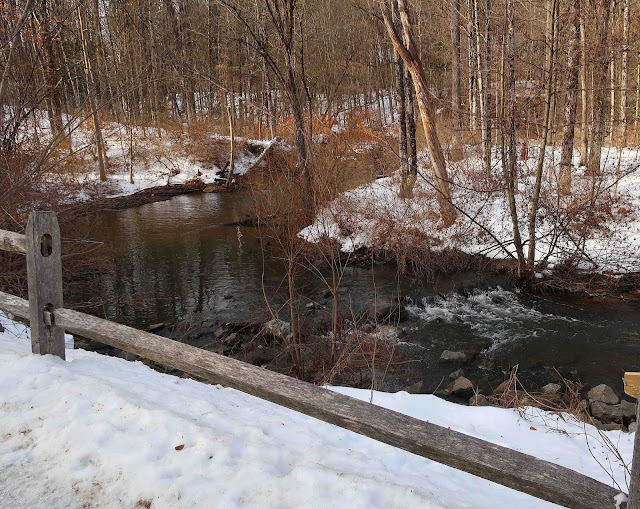My friends in the Thursday Naturalists and I are always on the lookout for interesting places to walk outdoors in the winter. But as the years go by and age- or accident-related injuries mount, we don't always want to challenge ourselves with long hikes through deep snow or up steep slopes. So this week I offered to lead our group along the Spring Run Trail, which lies within the city of Saratoga Springs. Following an old railroad bed, this flat and well-plowed trail runs about a mile from East Avenue until it dead-ends near the Northway, passing beneath steep wooded banks and along a rushing stream before it terminates in a cattail swamp.
A brand-new feature of the Spring Run Trail this year is the construction of a beautiful boardwalk that crosses that cattail swamp, connecting the trail to an apartment complex that lies at the end of Excelsior Avenue. I'm hoping our group might begin our walk here.
The boardwalk crosses the Spring Run Creek, which today was running full and fast, thanks to recent rains and melting temperatures.
This creek also runs close by many sections of the paved Spring Run Trail, so we can hear the sound of rushing water as we stroll along.
Although the Spring Run Trail passes through residential neighborhoods,
it definitely has a woodsy, rural feeling to it, offering an experience of nature right in the heart of the city. With plentiful open water and much wooded and wetland cover, the trail is a favorite spot for birds, so I'm urging my friends to bring their binoculars along. I did hear the sweet "Teakettle, teakettle, teakettle" song of a Carolina Wren in these woods today.
Since our naturalist group is primarily interested in plants, I imagine we will be testing our skills at identifying plants in their winter guises. I remember this spot in the trail as burgeoning with beautiful Great Lobelias last summer, so I stopped here today to see if I could find any remnants of these flowers.
Sure enough, I did!
The winter remnants of Teasels are always easy to spot, towering as they do over all other vegetation.
There's no missing the fuzzy scarlet fruits of Staghorn Sumac, either.
Or the tousled blond curls of Northern Willow Herb.
I know that these burry button-shaped tufts belong to the very tall sunflowers I admired along here last summer, but I never did figure out which species of sunflower they belong to.
The leaves of Sweet Fern still retained their wonderful fragrance when I crushed a few between my fingers. I love the elegant curves of their curling leaves and the furry little catkins that will open in spring to release their stores of pollen.
I'm not really happy to find the invasive Oriental Bittersweet climbing the trailside trees, but there's no denying those beautiful berries do add pleasing color to the winter landscape. Supplying abundant fruit, they also are one of the reasons that many species of birds winter over along this trail.
Two species of dogwoods, Silky and Red Osier, also add some bright color to the swampy spots. Both dogwoods shrubs have red twigs, but I can tell that this particular shrub is Silky Dogwood because of the vertical lenticels of its bark. The lenticels of Red Osier Dogwood look like pin dots instead of stripes.
I'm sure my naturalist friends will find many other items of interest when we explore this trail on Thursday, and I will be sure to return to this post and report them if they do.
Update: About 10 intrepid women showed up this clear, cold morning to brave the frigid wind and occasionally icy footing along the trail. We parked cars at each end of the trail so we could walk the entire length without backtracking, and we kept up a brisk pace, much brisker than this group of observant naturalists usually walks when exploring a trail. We didn't linger long over any of our plant finds. Thawing out over lunch and hot tea at my house afterwards, we all agreed the hike was most enjoyable, despite the cold. Here are a couple more photos from our walk along the Spring Run Trail.
I'm glad one of our group noticed the brilliant red fruits of Highbush Cranberry, which was growing in a swampy area well off the side of the trail.
I was surprised to see such plump, unwrinkled fruits, considering the many below-zero days we have had this winter and the multiple freezings the fruits would have undergone. They look so tempting, but I know from experience that they are very bitter. Best to leave them for the wildlife, who will eat them when little else remains.
As we neared the end of the trail, we came upon several clusters of Wild Bergamot, identifiable even now by the compactly bulbous seed heads and their minty scent when crushed. I know they are this particular species (Monarda fistulosa) because I always stop at this spot on the trail to admire their pretty pale-purple flowers when they bloom in summer.



















3 comments:
Look like a wonderful trail to be located inside the city. Increasingly I look for easy safe walking locations in the winter too. Not always easy to find.
I leave near this trail and your detailed descriptions and beautiful photos really enhance my enjoyment of my walks there.
I invested in Ice Bug boots this year and they have been worth EVERY penny! Even just to navigate sidewalks here in Saratoga.
Post a Comment